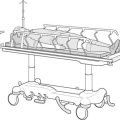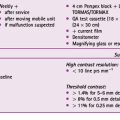Chapter 2 The law at work
 There are a number of acts of parliament and regulations that form the principal legislation of which you must be aware when working in a hospital.
There are a number of acts of parliament and regulations that form the principal legislation of which you must be aware when working in a hospital. Underpinning British health and safety law is the Health and Safety at Work etc. Act 1974, which sets out general duties for both the employer and the employee.
Underpinning British health and safety law is the Health and Safety at Work etc. Act 1974, which sets out general duties for both the employer and the employee. The Ionising Radiation Regulations 1999 and Ionising Radiation (Medical Exposure) Regulations 2000 are of particular interest.
The Ionising Radiation Regulations 1999 and Ionising Radiation (Medical Exposure) Regulations 2000 are of particular interest.THE HEALTH AND SAFETY AT WORK ETC. ACT 1974
The Health and Safety at Work etc. Act 1974 (HSWA) is the most important British health and safety law and is applicable to nearly every work activity. It is a huge document and its objective is to provide protection for people at work and for the general public. It does this by setting out general duties for both the employer and the employee. Failure to comply with these duties constitutes a criminal offence and both employers and employees can be prosecuted. It also provides the basis under which other health and safety regulations are enabled, the following of which are particularly relevant to radiographic work:
GENERAL DUTIES OF EMPLOYERS
Section 2(1) of the Act places a general duty on the employer:
To ensure so far as is reasonably practicable, the health, safety and welfare at work of all his employees1
GENERAL DUTIES OF EMPLOYEES
Employees have a number of duties and responsibilities. These include:
Sections 7 and 8 of the Act should be key to daily working practices. Section 7 of the Act states:
It shall be the duty of every employee while at work to take reasonable care for the health and safety of himself and of other persons who may be affected by his acts or omissions at work.1
THE MANAGEMENT OF HEALTH AND SAFETY AT WORK REGULATIONS 1999
Under section 3 of these regulations, the employer is required to undertake ‘suitable and sufficient assessment of the risks to health and safety’ to which their employees are exposed while they are at work.2
THE IONISING RADIATIONS REGULATIONS 1999 (IRR99)
PART 1 INTERPRETATION AND GENERAL
The first section provides, amongst other things, definitions of terms such as ‘dose rate’.
PART III ARRANGEMENTS FOR THE MANAGEMENT OF RADIATION PROTECTION
PART V CLASSIFICATION AND MONITORING OF PERSONS
This section deals with classified workers who are defined as any employee who is ‘likely to receive an effective dose in excess of 6 mSv per year or an equivalent dose which exceeds three-tenths of any relevant dose limit’.3 It also covers dose assessment and recording, medical surveillance and requirements in the event of an overexposure.
PART VI ARRANGEMENTS FOR THE CONTROL OF RADIOACTIVE SUBSTANCES, ARTICLES AND EQUIPMENT
This section deals with radioactive materials, their storage and transport and the need for accurate record keeping. There is also a requirement to notify the HSE in the event of certain occurrences including the spillage of a radioactive substance, which would give rise to a ‘significant contamination’.3 It also deals with installation, maintenance and quality assurance of equipment used for medical imaging.
THE IONISING RADIATIONS (MEDICAL EXPOSURE) REGULATIONS 2000 [IR(ME)R]
These regulations deal with the safe and effective use of ionising radiation used in clinical practice and they underpin all medical exposures.4 They are policed by the Department of Health. It is essential that you are completely familiar with these regulations.
IR(ME)R DUTY HOLDERS
There are four identified duty holders, whose responsibility it is to enforce these regulations:
The employer
The employer also has to establish:
The referrer
The ‘referrer’ is defined as being:
a registered health care professional who is entitled in accordance with the employer’s proceduresto refer individuals for medical exposure to a practitioner; ‘registered health care professional’ means a person who is a member of a profession regulated by a body mentioned in section 25(3) of the National Health Service Reform and Health Care Professions Act 2002.5
The practitioner
ADMINISTRATIVE AND PROCEDURAL ASPECTS OF PATIENT PROTECTION
Justification
Before an exposure can take place, an IR(ME)R practitioner must justify it. For an exposure to be justified, the benefit to the patient from the diagnostic information obtained should outweigh the detriment of the exposure. The exposure would normally be expected to provide new information to aid the patient’s management or prognosis. Under no circumstances can the routine radiography of ‘new’ patients prior to clinical examination be justified (Box 2.1).
Optimisation
For every X-ray exposure, the operator must ensure that doses arising from the exposure are kept ‘as low as reasonably practicable’ (ALARP) and consistent with the intended diagnostic purpose. This process is known as ‘optimisation’ andrelies heavily upon the professional competence and skill of the operator. So, while the operating procedures and protocols provide a framework, the operators should still use their skill and knowledge in deciding how best to perform individual exposures.
Female patients of childbearing age
‘Excessive’ exposure of patients
It should be noted that patients who undergo a procedure that was not intended (as a result ofmistaken identification for example), and thus exposed to a radiation dose, should be considered as having received an unintended dose. An investigation and notification to the IR(ME)R Inspectorate is required. It is therefore very important as an operator to ensure that you have the correct patient for the correct examination!
Medical physics expert (MPE)
Diagnostic reference levels (DRLs)
Quality assurance (QA)
The essential procedures within a programme suited to radiography will relate to:
Training
Regulation 4(4) of IR(ME)R 2000 places a responsibility on the employer to ensure that every IR(ME)R practitioner and operator has received adequate and appropriate training and undertakes continuing education/training after qualification. An up-to-date record of training must be maintained and be available for inspection. It is also a requirement that other persons who are directly concerned with the radiography (a parent supporting a child for example) are given adequate information to ensure their health and safety.
THE DATA PROTECTION ACT 1998
GENERAL PRINCIPLES
RIGHTS OF DATA SUBJECTS
THE REPORTING OF INJURIES, DISEASES AND DANGEROUS OCCURRENCES REGULATIONS 1995 (RIDDOR)
THE MANUAL HANDLING OPERATIONS REGULATIONS 1992
Manual handling is defined as:
‘An activity which involves lifting, lowering, carrying, pushing, pulling or supporting by hand or by bodily force’ 7
Manual handling is something that we all do every day. As a healthcare professional moving patients and equipment, you are even more susceptible to injury. In the year 2003/04, 10 040 ‘over-3-day’ injuries to employees in the health services sector were reported under RIDDOR. Of these, 53% (5361) were a result of manual handling accidents.8 It is essential, therefore, that you are aware of these regulations.
THE PERSONAL PROTECTIVE EQUIPMENT AT WORK REGULATIONS 1992
Personal protective equipment (PPE) relates to equipment designed to be worn or held by workers to protect them against one or more identifiedhazards. PPE should only be used when risks cannot be avoided or adequately reduced by technical means or safe systems of work.
THE CONTROL OF SUBSTANCES HAZARDOUS TO HEALTH REGULATIONS (COSHH)
The aim of these regulations is to prevent any disease arising from the use of chemicals and other hazardous materials in the workplace. These include substances used in work, such as adhesives and solvents, substances created by work activity (e.g. dust and fumes), naturally occurring substances and biological agents.9 You might question the relevance to radiographic practice until you consider that even in today’s environment of computerised/digital radiography, there are still photographic chemicals used in some areas of the department and these are regulated by COSHH.
The regulations place a number of duties on the employer:
As the employee, you have a duty under section 8 to make full and proper use of any control measure or system of work provided by the employer. Additionally, you have a responsibility to ensure anything you use under COSHH is returned afterwards to its proper place and, if defective, to report it to your employer.10
1 The Health and Safety at Work etc. Act 1974. London: HMSO.
2 Health and Safety Commission. In Management of health and safety at work: approved code of practice. London: HMSO; 2000.
3 The Ionising Radiations Regulations 1999. (SI 1999/3232). London: HMSO.
4 The Ionising Radiation (Medical Exposure) Regulations 2000 (SI 2000/1059). London: HMSO.
5 The Ionising Radiation (Medical Exposure) (Amendment) Regulations 2006 (SI 2006/2523). London: HMSO.
6 Department of Health. In Confidentiality: NHS code of practice. London: DoH Publications; 2003.
7 Health and Safety Executive. In Manual handling: Manual Handling Operations Regulations, 1992 – guidance on regulations. London: HMSO; 1992.
8 . Health and Safety Executive. Injuries and ill health in health services. 2005. Online. Available http://www.hse.gov.uk/statistics/industry/healthservices.htm
9 Health and Safety Executive. COSHH: A brief guide to the Regulations. In What you need to know about the Control of Substances Hazardous to Health Regulations 2002 (COSHH). Sudbury, UK: HSE Books; 2004/5.
10 The Control of Substances Hazardous to Health Regulations 2002 (SI 2002/2677). London: HMSO.
The Health and Safety at Work etc. Act 1974. http://www.healthandsafety.co.uk/haswa.htm
The Management of Health and Safety at Work Regulations 1999. http://www.opsi.gov.uk/si/si1999/19993242.htm
The Ionising Radiation Regulations 1999. http://www.opsi.gov.uk/si/si1999/19993232.htm
The Ionising Radiations (Medical Exposure) Regulations 2000 [IR(ME)R]. http://www.opsi.gov.uk/si/si2000/20001059.htm
The Ionising Radiation (Medical Exposure) (Amendment) Regulations 2006. http://www.opsi.gov.uk/si/si2006/20062523.htm
The Data Protection Act 1998. http://www.dh.gov.uk/PolicyAndGuidance/InformationPolicy/PatientConfidentialityAndCaldicottGuardians/fs/en
The Reporting of Injuries Diseases and Dangerous Occurrences Regulations 1995 (RIDDOR). http://www.opsi.gov.uk/si/si1995/Uksi_19953163_en_1.htm
The Manual Handling Operations Regulations 1992. http://www.opsi.gov.uk/si/si1992/Uksi_19922793_en_1.htm
The Control of Substances Hazardous to Health Regulations (COSHH). http://www.opsi.gov.uk/si/si2002/20022677.htm#3







